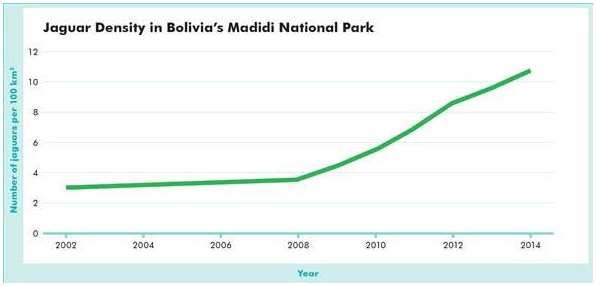
Jaguar populations have grown nearly 8 percent at WCS sites in Latin America between 2012-2016.Despite critical conservation gains, jaguars remain vulnerable to habitat destruction and killing due to conflict over livestock and for the illegal wildlife trade.

NEW YORK (March 1, 2018)—Jaguar populations have grown nearly 8 percent across field sites where the Wildlife Conservation Society works in Latin America from 2002 to 2016. In the sites analyzed, which include areas throughout Central and South America, the jaguar population either held steady or expanded, with a 3-fold increase in jaguar density in Bolivia’s Madidi National Park alone.
WCS conservationists attribute this success to strategic commitments to conserve the jaguar by local governments and communities, including effective law enforcement and ranching practices to reduce human-jaguar conflict.
WCS is releasing this good news about jaguars in recognition of World Wildlife Day on March 3 and as WCS co-hosts this week a high level forum on jaguars at the United Nations along with the Permanent Missions of Mexico and Colombia to the United Nations, and co-organized by WCS, UNDP, Conservation International, Panthera, and WWF.
Said WCS Vice President of Species Conservation, Dr. Elizabeth Bennett: “We are excited that our jaguar conservation efforts of the past two decades are showing signs of success. By continuing our work with governments, conservation partners, and local communities, we can look with optimism to the future for jaguars in the Americas. And that’s welcome news, indeed, on this World Wildlife Day.”
WCS works with partners to protect 5,000 jaguars and 400,000 square kilometers of jaguar habitat—from northern Paraguay to northern Central America.
From the mid-1800s to today, the total population of jaguars—the top carnivore of the tropical Americas—is estimated to have dropped from roughly 400,000 animals to approximately 60,000. Today, jaguars occupy only two-thirds of their pre-1900 range between the semi-arid scrub forests of Mexico and the flooded forests of the Amazon. The jaguar is now nearly absent from the United States in the northern part of its range and restricted to the extreme northern limits of Argentina in its southern range, while it has been eliminated across much of its historic range in Central America.
WCS Jaguar species coordinator Dr. John Polisar, said: “Two threats have taken a particularly heavy toll on the Americas’ largest cat species: habitat depletion due to the conversion of forest for development and agriculture, and killing in response to the loss of livestock.”
Because large top carnivores need a lot of space, successful conservation requires keeping substantial areas of forest habitat intact, including beyond the boundaries of protected areas.
“To this end, we have worked to support indigenous peoples who manage lands that neighbor protected areas,” said Dr. Lilian Painter, WCS Country Director for Bolivia.
In Bolivia’s Greater Madidi landscape WCS has supported the Tacana and other local people in securing land rights, reducing deforestation in their territory, and maintaining suitable habitat for jaguars. Those efforts have contributed to an encouraging recovery of jaguars in the park since 2002.
Despite the good news concerning jaguars, WCS Vice President for the Americans Program Dr. Julie Kunen cautions that we must remain vigilant and focused on our conservation mission. “One growing threat in the region is poaching of jaguars for the illegal trade in their parts, which are in demand in China.”
This year, World Wildlife Day is dedicated to raising awareness of the threats faced by big cats across the globe. World Wildlife Day was initiated in 2015 by a vote of the United Nations General Assembly to commemorate the adoption of the Convention on International Trade in Endangered Species of Wild Fauna and Flora (CITES) March 3, 1973. CITES is a critical international treaty that works to ensure that international trade does not threaten the survival of species in the wild.
Wildlife Conservation Society (WCS)
MISSION: WCS saves wildlife and wild places worldwide through science, conservation action, education, and inspiring people to value nature. To achieve our mission, WCS, based at the Bronx Zoo, harnesses the power of its Global Conservation Program in nearly 60 nations and in all the world’s oceans and its five wildlife parks in New York City, visited by 4 million people annually. WCS combines its expertise in the field, zoos, and aquarium to achieve its conservation mission. Visit: newsroom.wcs.org. Follow: @WCSNewsroom. For more information: +1 (347) 840-1242.





